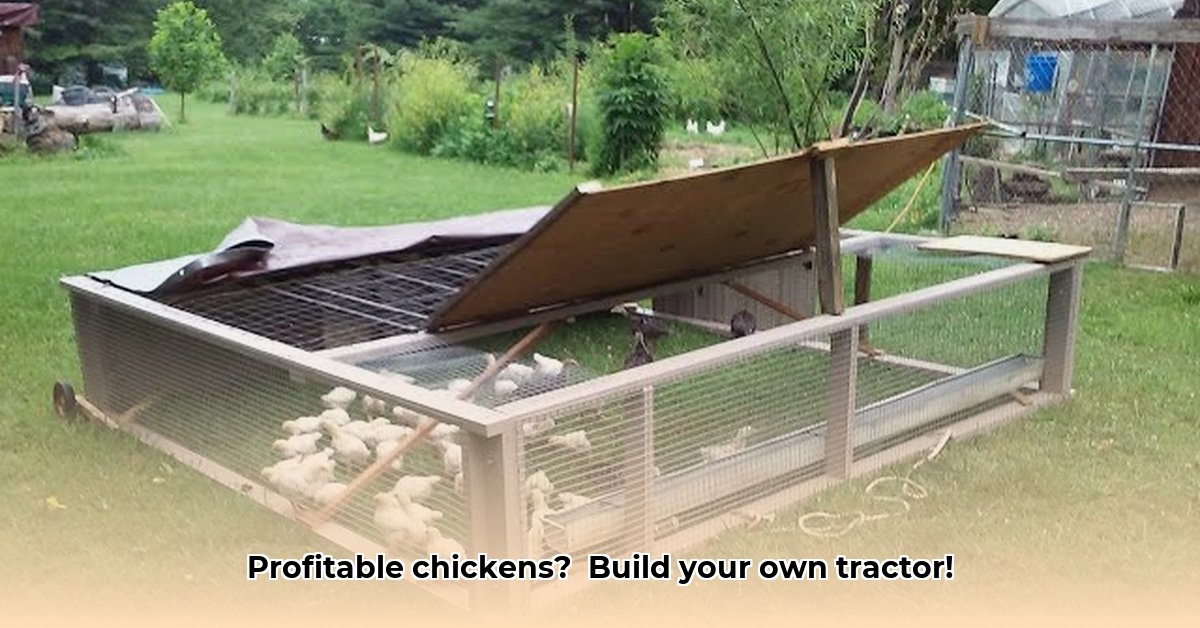
Ready to raise chickens the Joel Salatin way and turn a profit? Building a chicken tractor—a mobile coop that allows your flock to graze—is your ticket to pastured poultry success. This guide walks you through building, managing, and marketing your own sustainable and profitable chicken operation, whether you're a seasoned farmer or just starting out. For detailed plans, check out these chicken tractor plans.
Designing Your Mobile Chicken Coop: Size and Structure
Before grabbing your tools, determine your flock size. More chickens require more space for foraging. Numerous designs exist, from simple to complex; choose one aligning with your land, flock size, and building skills.
Frame: Use robust lumber like 2x4s for a strong rectangular frame. Dimensions depend on your flock size; longer tractors provide more grazing area.
Walls: Secure sturdy wire mesh (hardware cloth is recommended over chicken wire) to keep chickens inside and predators out.
Floor: Solid flooring (plywood or metal mesh) prevents soil compaction and simplifies cleaning. Add straw or bedding for comfort.
Door: A secure door is crucial for feeding, cleaning, and egg collection.
Wheels or Skids: Sturdy wheels or skids allow easy movement for efficient pasture rotation.
Predator Protection: A well-built coop is your initial defense. Consider additional measures like electric netting or a guardian animal. What predator control methods are most effective in your area? (This is crucial; research local wildlife.)
Materials List (Example for a Small Tractor):
- Pressure-treated 2x4 lumber
- Hardware cloth (1/2" mesh or smaller)
- Plywood or metal mesh for the floor
- Hinges and a latch for the door
- Wheels or skids
- Nails, screws, and other fasteners
Pasture Management: The Key to Happy Chickens and Healthy Soil
Pasture rotation is vital. Moving your chicken tractor to fresh sections regularly prevents overgrazing and maintains soil health.
Rotation Strategy (Example):
- Pasture 1: Chickens graze for 2 days.
- Pasture 2: Chickens move here for 2 days.
- Pasture 3: Follows the same pattern.
- Repeat the cycle, allowing at least a week for complete regrowth.
Adjust the rotation schedule based on your soil type and grass growth.
How long should you allow each pasture to rest before reintroducing your flock? (Careful observation is key.)
Flock Management: Ensuring Healthy, Productive Chickens
Happy chickens are productive chickens! Regular health checks, proper feeding, and clean water are essential.
| Task | Frequency | Tips |
|---|---|---|
| Feed Replenishment | Daily/As Needed | Ensure adequate feed; adjust quantities based on consumption. |
| Water Container Cleaning | Daily | Clean and refill daily to prevent disease. |
| Health Checks | Daily/Weekly | Monitor for illness or injury; seek veterinary care if needed. |
| Egg Collection | Daily | Gather promptly for freshness and to prevent breakage. |
| Pasture Inspection | Daily | Monitor grazing area for any issues or signs of overgrazing. |
Maintaining flock health is direct related to profitability; healthy chickens lay more eggs! What are the most common diseases affecting chickens in your region? (Proactive measures are vital.)
Predator Control: Protecting Your Flock
Predators pose a constant threat. Consider these protective measures:
- Electric Netting: A cost-effective barrier.
- Guardian Animals: A well-trained livestock guardian dog can be an excellent deterrent.
- Coop Design: Invest in a sturdy coop with reinforced walls and small mesh.
The required level of protection will depend greatly on your location and the local wildlife. What are the most prevalent predators in your area? (This dictates your security measures.)
Marketing Your Poultry Products: Reaching Your Customers
Direct-to-consumer sales maximize profits. Consider farmers' markets, local restaurants, and community-supported agriculture (CSA) programs. What are the most effective methods for marketing locally sourced poultry in your region? (Local preferences are key.)
Troubleshooting: Addressing Common Issues
Problems are inevitable. Here's how to address common challenges:
- Overgrazing: Adjust the rotation schedule or consider planting a grass mix.
- Predator Issues: Reinforce coop security and investigate additional predator control methods.
- Disease Outbreaks: Consult a veterinarian immediately; thorough cleaning and biosecurity measures are preventative.
Building a Salatin chicken tractor is about creating a sustainable farming system. While a learning curve exists, the rewards (fresh eggs, sustainable living) make it worthwhile.